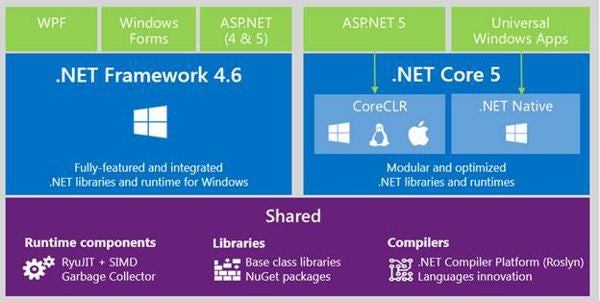Introduction
Over the recent years, we have noticed a shift in Microsoft from a company that focused exclusively on the desktop, to devices and services and the cloud, and most recently to increasing productivity.
As an enabler of the platform, this meant that .NET needs to evolve to match the changing business expectations. Developers today do not build only for a single platform. This means that Microsoft needs to support a cross-development strategy.
With Windows 10, Microsoft is attempting to answer a bunch of these questions. As a move to appeal to a broader spectrum of developers, .NET has been made open source recently.
.NET 2015
The components of .NET 2015 are beautifully illustrated in Figure 1.
(Image courtesy: Microsoft build 2015 presentation)
Figure 1: .NET 2015’s components
As you can see from the Figure 1, NET 2015 is powered by .NET Core 5, which is composed of CoreCLR and .NET Native (which are modular and optimized .NET libraries and runtimes), and .NET Framework 4.6.
The shared components include:
- The .NET compiler platform, also called Roslyn.
- Base class libraries that are available as Nuget packages
- Runtime components such as JIT and garbage collector
All of these power the various apps that run the following: WPF, Windows Forms, ASP.NET, and Universal Windows Apps.
.NET Framework 4.6
This new version of .NET framework is a compatible, in-place replacement for older version of .NET.
WPF improvements in .NET Framework 4.6 include these features:
- Touch events for multi-touch scenarios are reported more reliably.
- Scrolling a list is more reliable.
- No layout cycles during virtualization.
- (New) support for multi-dpi cursor and monitor support.
The new Blend for Visual Studio 2015 is integrated with Solution Explorer, Team Explorer, and Editor.
.NET Compiler Platform: Roslyn
This has been announced for some time, but it will become public (non-beta) with. NET 2015.
The compiler technology behind .NET has become open source.
Compiler APIs are now exposed that allow developers to extend them to use, to provide a Visual Studio-like experience.
We have covered Roslyn in an earlier article.
Cross-platform Development Support
One of the most radical changes coming this summer is the support for cross-platform development. Developers now can build native applications for Windows, iOS, and Android devices using .NET.
To reduce the friction that developer sensed to build across platforms, Microsoft is building the ability to support cross-platform app development.
Developers can now share app logic across platforms and maximize code reuse with Universal Projects and Portal Class Libraries.
Because 100% of APIs on other platforms are exposed, whatever developers can do on xCode or ADT can be done in Visual Studio. So, developers now can work on only one platform and use it for designing, building, as well as debugging their application.
As developers, we should all feel pretty excited about these upcoming changes.
Summary
In this article, we learned about the developer facing changes coming in .NET 2015. I hope you have found this information useful.
About the Author
Vipul Patel is a technology geek based in Seattle. He can be reached at vipul.patel@hotmail.com. You can visit his LinkedIn profile at https://www.linkedin.com/pub/vipul-patel/6/675/508.


